Big move in pro creative software. Canva has relaunched Affinity as a single, studio-grade app that combines vector design, photo editing, and page layout — and starting today it’s free for everyone on Windows and macOS (with an iPad version “coming soon”). No cut-down SKUs, no subscription: Canva is pitching “free forever” performance to compete head-on with Adobe’s ecosystem.
The news lands about a year after Canva acquired Serif, the company behind Affinity. Back then, Canva promised to preserve Affinity’s pro muscle; today it’s making good with an “all-new Affinity” and a fresh brand identity.
What’s in the new Affinity
The headline change is unification. Instead of three separate apps (Designer, Photo, Publisher), Affinity is now a single environment combining vector tools, advanced photo editing (including RAW development, non-destructive adjustments, live filters, and batch processing) and multi-page layout with Master Pages, shared text styles, and advanced typography.
The company leans hard on performance: GPU acceleration, instant previews, smooth pan/zoom even on heavy documents, and a striking claim — accurate view up to 10,000,000% zoom — aimed squarely at high-precision work.
Highlights at a glance
- Three disciplines, one app: vector, photo, and layout without app-switching.
- Non-destructive editing and real-time workflow.
- Custom “Studios”: mix and match Vector/Pixel/Layout tools, save and share workspaces.
- Format compatibility: open/import PSD, AI, PDF, SVG, TIFF, IDML, and more.
- Cost: the full version is free for everyone (no feature gating in the desktop app).
- Availability: Windows & macOS today; iPad coming soon.
What about AI? Optional Canva tie-ins
The new Affinity doesn’t require a subscription, but if you have Canva Premium you’ll see Canva AI Studio inside Affinity with features like Generative Fill, Expand & Edit, and Remove Background. Canva says creative work is not used to train AI models and that its AI is built with privacy controls.
You can also export Affinity projects to Canva in a few clicks — a first bridge from desktop pro workflows to Canva’s collaborative, publishing-oriented platform.
Why this matters: lower barriers, direct pressure on Adobe
For years, creatives have complained about two things: rising subscriptions and bloated tools that slow them down. Canva’s Affinity play hits both:
- Price: removing the monthly fee changes the equation for freelancers, small studios, schools, and SMBs that relied on Creative Cloud or stitched together free tools.
- Speed & focus: Affinity’s pitch is snappiness and true real-time editing — a pain point for designers working with dense files, brand systems, or long-form layouts.
For Adobe, this isn’t trivial. Affinity has long been the “plan B” for many professionals; with pro-grade free and a single studio covering three pillars, competitive pressure just went up. Adobe still owns the ecosystem (Photoshop/Illustrator/InDesign, After Effects, Lightroom, Firefly, fonts, plugins, cloud workflows), but the entry barrier just dropped sharply.
What designers are saying
Affinity has earned loyal fans over the last decade for precision and speed. Canva says this new chapter was built “in close collaboration” with the community — thousands of requests and a Designer Advisory Board — and it’s positioned as evolution, not disruption: the tools and workflows you know are still here, refined rather than replaced.
Day-to-day upsides
- Less context switching: vector, pixel, and layout on the same workbench.
- Deep workspace customization with shareable Studios for teams.
- Gentler learning curve for existing Affinity users; Adobe import helps transitions.
Open questions
- iPad timing: no specific date yet.
- Ecosystem & plugins: Affinity doesn’t have (or promise) a plugin marketplace on Adobe’s scale — watch this space.
- Enterprise workflows: color management, Pantone/licensing, automation, shared libraries, and review — worth vetting in larger environments.
“Free” isn’t “no strings”: what to know
While there’s no fee, you’ll need a Canva account to download/activate Affinity. Canva AI and cloud export are optional, but if enabled, they create a hybrid flow: desktop for creation and Canva for collaboration/publishing.
Teams handling sensitive assets (IP, regulated data) should review privacy terms and configure which cloud features are allowed.
Getting started
- Download from Affinity’s site (Windows/macOS).
- Sign in with your Canva account (or create a free one).
- Import your files: open PSD, AI, PDF, SVG, TIFF, IDML, etc.
- Customize your Studio: mix Vector/Pixel/Layout tools, save presets, share with teammates.
- Decide on AI: if you have Canva Premium, choose which Canva AI features fit your workflow and privacy policies.
- Export/publish: work locally and export to Canva if you need collaboration or distribution.
The bigger picture
A free, pro-grade Affinity shakes multiple segments:
- Education: schools/universities can standardize on pro workflows without per-seat licensing.
- SMBs & makers: instant access to high-end tooling with zero recurring cost.
- Talent market: more creatives trained on Affinity could pressure de-facto standards and improve interoperability.
- Competition: alongside tools like DaVinci Resolve (video) or Blender (3D), it expands the space for pro tools without subscriptions.
For creatives, the question is no longer whether an alternative exists, but which workflow fits best. For the industry, it’s whether Canva’s balance of price, performance, and ecosystem is strong enough to move entrenched Creative Cloud users.
TL;DR
- Affinity reborn as a unified vector/photo/layout app with a focus on performance and customization.
- Available now on Windows & macOS, and free forever per Canva; iPad version to follow.
- Canva AI integrates optionally for Premium accounts; vendor says user work is not used to train AI.
- The move drops the entry barrier to pro creative tooling and turns up the heat on Adobe, while surfacing new decisions around workflows, privacy, and ecosystems.
The next phase of creative tooling won’t be won on feature checklists alone, but on the best mix of power, cost, and control. With Affinity free and consolidated into a single studio, Canva clearly wants your next campaign, brand system, or 200-page magazine to be built on its turf. Now we’ll see how the rest of the industry answers.


